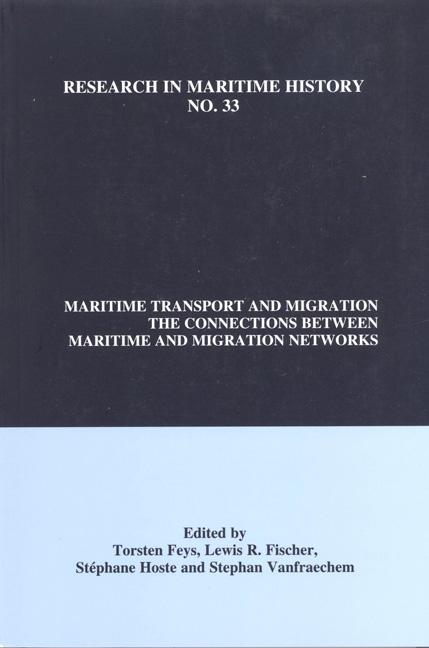Book contents
- Frontmatter
- Contents
- Contributors' Notes
- “Migration and Maritime Networks in the Atlantic Economy: An Introduction”
- “The First Waves of Internationalization: A Comparison of Early Modern North Sea and Nineteenth-Century Transatlantic Labour Migrations”
- “The Battle for the Migrants: The Evolution from Port to Company Competition, 1840-1914”
- “The Role of Foreign-bora Agents in the Development of Mass Migrant Travel through Britain, 1851-1924”
- “Transatlantic Emigration and Maritime Transport from Greece to the US, 1890-1912: A Major Area of European Steamship Company Competition for Migrant Traffic”
- “The ‘Relatives and Friends Effect:’ Migration Networks of Transatlantic Migrants from the Late Habsburg Monarchy”
- “Crossing the Last Frontier: Transatlantic Movements of Asian Maritime Workers, c. 1900-1945”
- “Costs, Risks and Migration Networks between Europe and the United States, 1900-1914”
- “Conclusion”
“The First Waves of Internationalization: A Comparison of Early Modern North Sea and Nineteenth-Century Transatlantic Labour Migrations”
- Frontmatter
- Contents
- Contributors' Notes
- “Migration and Maritime Networks in the Atlantic Economy: An Introduction”
- “The First Waves of Internationalization: A Comparison of Early Modern North Sea and Nineteenth-Century Transatlantic Labour Migrations”
- “The Battle for the Migrants: The Evolution from Port to Company Competition, 1840-1914”
- “The Role of Foreign-bora Agents in the Development of Mass Migrant Travel through Britain, 1851-1924”
- “Transatlantic Emigration and Maritime Transport from Greece to the US, 1890-1912: A Major Area of European Steamship Company Competition for Migrant Traffic”
- “The ‘Relatives and Friends Effect:’ Migration Networks of Transatlantic Migrants from the Late Habsburg Monarchy”
- “Crossing the Last Frontier: Transatlantic Movements of Asian Maritime Workers, c. 1900-1945”
- “Costs, Risks and Migration Networks between Europe and the United States, 1900-1914”
- “Conclusion”
Summary
The nineteenth century is commonly regarded as the period in which Europe experienced the first wave of globalization. Kevin O'Rourke and Jeffrey Williamson's seminal Globalization and History argues plausibly that between 1840 and 1914 the world underwent a radical change. One of the most striking elements of what they call a “wave of globalization” was treated more thoroughly in another of Williamson's books, this time co-authored with Timothy Hatton, entitled The Age of Mass Migration. In this latter work the authors deal with the economic causes and consequences of the mass migration from Europe when about fifty-five million Europeans relocated to the New World between 1850 and 1914.
Despite its important contribution to the historiography of migration in general and nineteenth-century migration in particular - not least because of its econometric approach - it is possible to criticize Hatton and Williamson's book for its narrow limits in time and space. Spatially, the authors’ focus is almost solely on the migration of Europeans to North America, thereby neglecting the movements of people from Europe to South America, the Caribbean and Asia. It would be useful to know whether the inclusion, for instance, of the forced deportation of Englishmen to Australia, or the emergence of new colonial regimes through the migration of civil servants from Europe to the new colonies, would fit the model that is now based solely upon the migration of free labour across the North Atlantic. In this essay, however, I will deal not with the book's narrow spatial focus but rather with Hatton and Williamson's claim that the nineteenth century was unique in terms of mass migration.
In The Age of Mass Migration - as in much of the pre-1980 historiography on European migration - European population before the onset of the nineteenth-century transatlantic migrations is treated as fairly immobile. This may be true compared with the explosion of European emigration beginning in the mid-nineteenth century, but to analyze pre-industrial European mobility this way is wrong because not only were America and Europe less integrated in this era but pre-industrial Europe itself was far less integrated than in the second half of the nineteenth century.
- Type
- Chapter
- Information
- Maritime Transport and MigrationThe Connections Between Maritime and Migration Networks, pp. 9 - 26Publisher: Liverpool University PressPrint publication year: 2007



